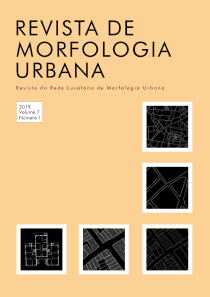Abstract
The present work analyzes the configuration of the favela from its socio-spatial patterns, seeking to understand the phenomenon in its global scale. It adopts the Social Logic of Space (Space Syntax) as theoretical, methodological and technical approach, allowing the reading of the object in its spatial complexity. A total of 120 settlements located around the world are compared, using a set of 26 configurational variables (between qualitative and quantitative, geometric and topological). The results are also compared to a sample of 45 Portuguese cities of medieval origin (exemplars of the organic city) and by Medeiros research for 44 Brazilian cities (2013) (illustrative of contemporary urban structures). The research questions are considered: is there a favela spatial pattern? and to what extent the favela reproduces spatial patterns inherent to the organic and historically consolidated city? The research is based on the hypothesis that the favela configuration reveals spatial patterns derived from its self-organizing practices, which are responsible for successful urban dynamics. The findings reveal that the favela is organized within the larger system that receives it, sharing a common and transversal logic in the various regions of the world, despite its varied cultural contexts. There were also found common patterns in organic cities and favelas, revealing similar processes of development
References
Alexander, C. et al. (1977) A pattern language. New York, Oxford University Press.
Batty, M.; Longley, P. (1994) Fractal cities: a geometry of form and function. London, Academic Press.
Guerreiro, R. (2010) Urbanismo orgânico e a ordem implícita: uma leitura através das geometrias da natureza. Tese de Doutoramento apresentada em 2010, ISCTE-IUL Escola de Tecnologias e Arquitectura.
Hillier, B. (2016) What are cities for? And how does this relate to their spatial form? – The Journal of Sapce Syntax - Volume 6, n.2, p.199-212.
Hillier, B.; Hanson, J. (1984) The social logic of space. Londres, Cambridge University Press.
Hillier, B.; Vaughan, L. (2007) The city as one thing. Progress in Planning, v.67, n.3, pp.205-230.
Hillier, B., Yang, T., Turner, A. (2012) Normalising least angle choice in Depthmap - and how it opens up new perspectives on the global and local analysis of city space. In Journal of Space Syntax (JOSS), Vol.3, n.2, p.155-193.
Holanda, F. (2002) O espaço de exceção. Brasília, EdUnB.
Jacques, P. (2006) Learning from favelas. Em: Nunes, Brasilmar Ferreira (org.). Sociologia de Capitais Brasileiras: Participação e Planejamento Urbano. Brasília, Líber Livro Editora, pp. 179-202.
Loureiro, V. R. T. (2017) “Quando a gente não tá no mapa": a configuração como estratégia para a leitura socioespacial da favela. Brasília. Tese – Programa de Pesquisa e Pós-Graduação da Faculdade de Arquitetura e Urbanismo da Universidade de Brasília.
Medeiros, V. A. S. (2016). Uma herança do ultramar 05: análise da configuração urbana em cidades lusófonas. Projeto de Pesquisa (Iniciação Científica), PPG/FAU/UnB, Brasília.
Medeiros, V. A. S. (2013) Urbis Brasiliae: o labirinto das cidades brasileiras. Brasília, EdUnB.
Morin, E. (1990) Introdução ao pensamento complexo. Lisboa, Instituto Piaget.
Rolnik, R. (2015) Guerra dos lugares: a colonização da terra e da moradia na era das finanças. São Paulo: Boitempo.
Salingaros, N. A. (trad. Livre Salomão, L.) (1998). A teoria da teia urbana, Journal of Urban Design, v. 3, p. 53-71. Taylor & Francis Limited.
Salingaros, N. A. (2005) Principles of Urban Structure, Design Science Planning, Amsterdam: Techne.
Salingaros, N. A. (2010) Twelve Lectures on Architecture - Algorithmic Sustainable Design. Solingen: Umbau-Verlag.
Salingaros, Nikos A. et al. (trad. Livre Salomão, L.) (2006) Habitação Social na América Latina: uma Metodologia para Utilizar Processos de Auto-organização. Apresentado no Congresso Ibero-Americano de Habitação Social, Florianópolis, Brasil.
Sobreira, F. (2002) A lógica da diversidade: complexidade e dinâmica em assentamentos Espontâneos. Recife, 2002. Tese (Doutorado em Desenvolvimento Urbano) – Programa de Pós-Graduação em Desenvolvimento Urbano, Universidade Federal de Pernambuco, Recife.
Wirth, L. (1938) Urbanism as a way of life. The American Journal of Sociology, Vol. 44, No. 1 (Jul.), pp. 1-24. The University of Chicago Press Stable. Disponível em: http://www.jstor.org/ stable/2768119. [Acessado em 31 julho 2017].
Os direitos autorais permanecem com os autores, que autorizam a Revista de Morfologia Urbana a publicar o artigo sob uma licença Creative Commons Atribuição (CC-By).


